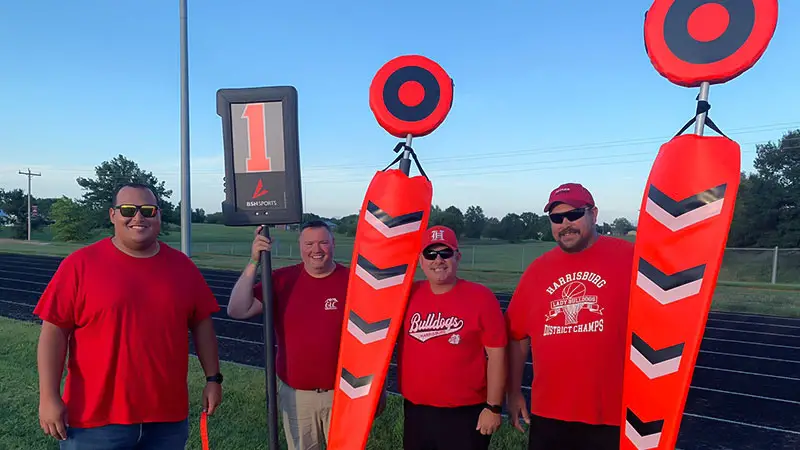In the world of football, the down marker and chains play a crucial role in determining the progress of the game.
These seemingly simple tools provide fans, players, and officials with essential information about the distance needed for a first down. Without them, the game would lack the precise measurements that keep it fair and competitive.
The down marker, often seen on the sidelines, indicates the current down number, while the chains measure the ten yards a team must advance to earn a new set of downs.
Together, they ensure the game flows smoothly and maintain the integrity of the sport. Understanding their function not only enriches the viewing experience but also highlights the meticulous nature of football’s rules and regulations.
Overview of Football Down Marker and Chains
Football down markers and chains are fundamental tools in the sport. They define the distance needed to achieve a first down.
The down marker displays the current down number, aiding players, officials, and spectators in understanding the game’s progression.
The chains, measuring precisely ten yards, determine how far the offense must go to secure a new set of downs.
Together, these devices uphold the standards of fair play and ensure accurate measurement on the field. The consistency they bring highlights the meticulous nature of football’s rules and enhances the game’s integrity.
Components and Functionality
Football down markers and chains are integral to the sport, defining gameplay structure.
Here’s an in-depth look at each component and its role.
Down Marker
The down marker indicates the current down number. This device typically consists of a pole with a box-like indicator. It displays numbers 1 through 4 to signify which down the offense is on.
Positioned along the sideline, it aids players, officials, and spectators in tracking game progress. Electronic versions are now common, featuring LED displays for better visibility and accuracy.
Chains
Chains measure the ten yards needed for a new set of downs. This tool comprises two poles connected by a 10-yard long chain.
Officials place one pole at the forward progress point of the ball and the other ten yards downfield. A crucial part of the measurement process, these chains ensure precise distance calculation, maintaining game integrity.
When a first down is close, officials use the chains for an exact measurement, often determining game outcomes.
Importance in the Game
Down markers and chains play vital roles in football, influencing game dynamics at every level. They ensure fair play while shaping game strategy.
Role in Game Management
Down markers and chains provide officials with reference points, aiding in accurate calls. Markers indicate the current down, while chains measure yardage for a first down.
Consistent placement ensures continuity. Officials use these tools to monitor play sequences, validate progress, and enforce rules.
Impact on Strategy
Teams rely on down markers and chains to inform play choices. Coaches observe the marker’s position to gauge risk and reward. When the down number is high, teams may opt for safer plays.
Chains offer precise distance measures, influencing whether a team attempts a running play or a passing play. These elements allow for strategic adjustments during critical moments.
Types of Down Markers and Chains
Various types of down markers and chains exist, serving different needs in football. They vary in design, functionality, and technology.
Traditional Sets
Traditional down markers and chains are manual tools used widely across all levels of play. The down marker is a pole, typically around 7 feet tall, with a numbered sign on top indicating the current down (first to fourth).
These signs often involve flipping numbers as play progresses. The remote official holding the marker adjusts the numbers as each play completes.
Chains are linked metal segments totaling 10 yards in length. Two officials hold the ends, positioning them precisely to measure the distance required for a first down.
These chains maintain player positioning and tracking progress meticulously. Both markers and chains work together to provide clear visual cues on the field.
Advanced Electronic Systems
Advanced electronic systems introduce technology to improve accuracy and efficiency. Electronic down markers use LED displays to indicate the current down, eliminating manual flipping.
Additionally, these markers often incorporate wireless communication with the scoreboard and officials, ensuring seamless updates.
Electronic chains integrate sensors and GPS technology, providing real-time distance measurements. These systems offer enhanced precision in determining first down distances.
They also connect to the stadium’s digital systems for synchronized and accurate updates. Advanced electronic systems are becoming more prevalent in professional and major collegiate games, pushing the boundaries of accuracy and efficiency in football.
How to Choose the Right Football Down Marker and Chains?
Choosing the right football down marker and chains is crucial for accurate game management and maintaining the flow of play.
Here are some key factors to consider:
Material and Durability
Look for down markers and chains made from high-quality, durable materials such as heavy-duty plastic or metal. The markers should be weather-resistant to withstand various conditions.
Choose products known for their longevity, with high-impact plastic or metal options typically offering better durability and the ability to handle rough use.
Visibility
Opt for markers that are brightly colored and easily visible from a distance. High-contrast colors like fluorescent green or orange are popular for their visibility on the field.
Some markers come with reflective strips or elements to enhance visibility during low-light conditions or night games.
Size and Weight
The down markers should be large enough to be seen clearly by players, referees, and spectators. Typically, down markers are around 18-24 inches tall.
Ensure the markers are sturdy but not overly heavy; they should be stable enough to stay in place but light enough for easy handling and placement.
Ease of Use
Look for down markers with adjustable components that can be easily set to the correct yardage. This feature simplifies game management and ensures accuracy.
Choose markers that are easy to transport and store, with many coming with carrying bags or cases for convenience.
Chain Length and Quality
The chain should be long enough to cover the required distance between the markers. Standard chains are typically 10 yards long, but ensure they meet the specific needs of your league or association.
Chains should be heavy-duty and able to withstand tension and wear, with rust-resistant materials recommended if they will be exposed to weather.
Compatibility and Regulations
Check if your league or association has specific regulations or standards for down markers and chains. Ensure the equipment you choose complies with these requirements.
Verify that the markers and chains are compatible with other equipment you use, such as field goal posts and yardage markers.
Brand and Reviews
Opt for markers and chains from reputable brands known for their quality and reliability. Brands with good reviews and endorsements from other teams or leagues are often a safe bet.
Reading reviews and feedback from other users can help gauge the performance and reliability of the markers and chains you’re considering.
Maintenance and Safety
Proper maintenance and safety protocols are essential for the longevity and safe operation of football down markers and chains.
Common Issues
Common issues with football down markers and chains include wear and tear, malfunctioning electronic components in advanced systems, and damage from rough handling.
Regular inspections and prompt repairs prevent these problems from affecting game accuracy. For example, checking for frayed chains or worn-out numbers ensures replacements are done timely. Ensure batteries and electronic displays are functional before games.
Safety Protocols
Safety protocols for down markers and chains prioritize both user safety and accurate functionality. Ensure that all personnel handling the equipment receive adequate training to understand their operation.
Position markers and chains to avoid player collisions and sideline obstructions. Use only weather-resistant materials to prevent hazards due to environmental conditions. For instance, thicker, high-visibility chains reduce trip hazards and enhance usability.
Frequently Asked Questions
What are football down markers and chains used for?
Football down markers and chains are essential tools used to measure the distance remaining for a first down. They help in structuring gameplay and ensuring fairness by providing a visible and accurate reference for players, coaches, and referees.
How have down markers and chains evolved over time?
Down markers and chains have evolved from traditional manual sets to advanced electronic systems. This transition improves accuracy, visibility, and ease of use, significantly enhancing the efficiency and strategy of modern football games.
What should I consider when buying down markers and chains?
When purchasing down markers and chains, consider factors like durability, visibility, weight, measurement accuracy, ease of use, and weather resistance. Additionally, budget aspects such as initial cost, replacement parts, bundle deals, and warranties are crucial for an informed decision.
How important is maintenance for down markers and chains?
Regular maintenance is vital to ensure optimal performance and longevity. This includes regular checks for durability, prompt replacements for worn-out parts, and careful handling to maintain measurement accuracy and visibility.
Are there safety considerations for down markers and chains?
Yes, safety is a key consideration. Ensure the markers and chains are made from durable and lightweight materials to prevent injuries. Additionally, visibility features should be designed to enhance safety for players and officials during gameplay.
What are the benefits of electronic down markers?
Electronic down markers offer several advantages, including improved accuracy and better visibility under various weather conditions. They are also easier to use and can display additional information, enhancing the overall game experience.
Conclusion
Football down markers and chains are essential tools for ensuring structured gameplay. They track game progress accurately, influence strategies, and maintain fairness.
Traditional manual sets offer simplicity, while advanced electronic systems add precision. Proper maintenance ensures longevity and optimal performance. Regular checks for wear and tear, along with prompt replacements, maximize their utility.
When purchasing, buyers should consider durability, visibility, weight, measurement accuracy, ease of use, and weather resistance.
Durable materials withstand frequent use, while high visibility enhances readability. Lightweight models are easier to handle, and accurate measurements avoid disputes. User-friendly designs and weather-resistant features further add value.
Budget considerations include initial cost, replacement parts, bundle deals, and warranties. Initial costs vary based on complexity, with basic models being more affordable. Availability of replacement parts ensures extended usability.
Bundle deals often provide cost savings, and warranties protect against defects, offering long-term security.








Ashley Hopkinson